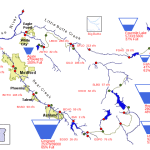Email to Ashland Council Questions the City Hall Bond based on the Facts
Geologist Bill Burns Comment Regarding City Hall Structure
At this Council meeting you discussed a conversation I had with Bill Burns of the Oregon Department of Geology that I later raised at the recent town hall. It was intimated that I had somehow acted in a negligent manner by not informing Bill that our city hall was of masonry construction. This is not true.
When investigating the seismic vulnerability issue of City Hall, I found that it depends on two factors, the ground the building sits on and the susceptibility of the building. I also found that city hall sits on very stable land that is rated as a lowest hazard zone (https://www.oregongeology.org/pubs/ims/p-ims-009.htm) with no amplification and liquefaction risks. I then talked with Mr. Burns at DOGAMI who verified that my data on the land was valid. I had no reason to discuss the structure vulnerability with him since the city already had a seismic study of the building from Miller Engineering. Rather, I focused my attention on the land factor you had ignored and presented the results of that investigation at the town hall.
Also, you mentioned in this meeting that Ashland School District had gotten several grants to do seismic retrofits for some of these buildings. From this you concluded that this meant that the City Hall was in danger because of these grants. Indeed, the State has determined that it would be good public policy to make sure critical buildings (schools, police and fire department) should be retrofitted if they are seismic susceptible . Kudos to the School Board for taking advantage of these grants but they have no relevance to City Hall. The land that is North and East of Main and Siskiyou is not as safe as the City Hall land because it is rated as a low amplification area rather than no amplification area for City Hall.
Earthquake Probability
In my previous email to you I pointed out the low probability of an earthquake that would cause significant damage for City Hall. Further investigation has revealed that the probability of Cascadian Level 9 in the next 50 years that affects the entire Northwest is between 7.5% and 15% (https://www.oregon.gov/oem/Documents/01_ORP_Cascadia.pdf). Let’s assume we can solve the City Hall issue in the next two years. This means the probability drops to between 0.28% and 0.6%. Also factor in the fact that City hall is only occupied 50% of the time and this drops the probability to between 0.14 to 0.3%.that people might be trapped in the building. If we also consider a Level 8 earthquake in the next 50 years (which is 10 times less in magnitude from a Level 9), the odds of an earthquake increases, but the probability still is less than 1% with this same analysis. On top of that the Miller Engineering study stated that the structure may not allow for safe exit from the building which means that there is a chance that it will allow for a safe exit.
In addition, I found that the State has calculated what the potential peak ground acceleration is for a Cascadia Level 9 earthquake event (https://www.oregongeology.org/pubs/ofr/p-O-13-06.htm) and has rated areas in the State from 1 to 9 with 1 being the largest acceleration. This acceleration is the major cause for destruction for a masonry building that is in a no liquefaction area. Ashland is rated a 7 with acceleration at ¼ of the amount at level 1. In this same report, Ashland is in a Light ground acceleration area where for a level 9 quake it is quoted ”felt by all; windows crack; dishes, glassware, books fall off shelves; pictures fall off walls; furniture moved; weak plaster, adobe buildings and poorly built masonry cracked”
Why Panic
My whole point in doing this was to challenge the panic mode that was developing around this seismic issue and your using it as the major selling point in getting approval of the bond proposal. I heard comments about having to move employees out of the building because they were in danger and big city financial liability, all trying to scare the citizens of Ashland into supporting this bond measure when the real reason was the powers that be just wanted a new city hall.
My view that you just wanted a new city hall is supported by the fact that 4 years ago in 2016 you had the seismic report from Miller Engineering and a recommended solution for curing the problem with a seismic upgrade that would have cost $1.4 million. This approach was also recommended by the Ad-Hoc committee formed to study this problem. If you were so concerned about seismic vulnerability and the city’s liability, you would have done this upgrade immediately. Nothing has changed since that time so why the panic now? Obviously, some of you saw a chance get a new city hall and you have spent the last 4 years trying to justify this approach.
Ironically, we could have used the $1.7 million that was transferred from the facilities maintenance fund to the central services fund to more than cover this seismic upgrade project. Furthermore, we could have used the $300 thousand in design fees that were spent for a new city hall to cover much of the Pioneer Hall and Community Center projects and thus we wouldn’t be discussing the need for a bond and another tax on Ashlanders.
If you want a new city hall, then make this case to the citizens of Ashland without resorting to the scare tactic of a possible earthquake. Also, take the suggestions I have heard from others to use an architect that is familiar with historic building restoration and set a reasonable cost target that voters of Ashland can live with. This is the right way to go about a bond measure.
Ken Wilson – Ashland






